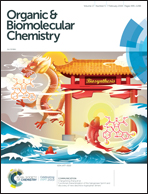The irony of chirality – unveiling the distinct mechanistic binding and activities of 1-(3-(4-amino-5-(7-methoxy-5-methylbenzo[b]thiophen-2-yl)-7H-pyrrolo[2,3-d]pyrimidin-7-yl)pyrrolidin-1-yl)prop-2-en-1-one enantiomers as irreversible covalent FGFR4 inhibitors†
Abstract
The influence of chirality on the therapeutic activities of drug molecules has remained an interesting subject matter in drug design. The recent identification of two chiral irreversible inhibitors with differential inhibitory activities towards oncogenic fibroblast growth factor receptor 4 (FGFR4) presented an avenue to investigate the underlying mechanisms that accounted for their disparate activities. Accordingly, the S-configured form (9g) exhibited ‘15 times’ potency than the corresponding R-configured (9h) form. Nonetheless, the big question remains how does chirality influence their inhibitory potencies? Therefore, in this study, we seek to provide useful insights into this interesting phenomenon using molecular dynamics simulations and free binding energy calculations. Interestingly, we observed that the inhibitory 9g activity correlates with a coordinated movement of the active site p-loop, as specifically induced by the S-configuration, which allowed the rotation of three dihedral angles; φ1(CNCO), φ2(CCC*N) and φ3(CCCC), thereby achieving optimal orientations suitable for interactions with crucial active site residues such as LEU473, LYS503, ASP641 and TYR643. Consequentially, while the 9h-bound FGFR4 active site was highly unstable, 9g exerted an inward pulling effect which accounted for active site stability and compactness. Also, the positional movement of 9h (R-configuration) at the active site was restricted, thereby preventing interactions with key residues. Moreover, 9g exhibited the most favorable binding as compared to 9h which showed a relatively lower ΔGbind. The higher binding affinity of 9g to FGFR4 can be mainly attributed to the increase in van der Waals energy by −4.12 kcal mol−1 and electrostatic by −2.89 kcal mol−1. The difference in van der Waals interactions is mainly determined by two residues; ASP641 and TYR643, whilst, the difference in electrostatic interactions is primarily determined by two residues LEU473 and LYS503.
![Graphical abstract: The irony of chirality – unveiling the distinct mechanistic binding and activities of 1-(3-(4-amino-5-(7-methoxy-5-methylbenzo[b]thiophen-2-yl)-7H-pyrrolo[2,3-d]pyrimidin-7-yl)pyrrolidin-1-yl)prop-2-en-1-one enantiomers as irreversible covalent FGFR4 inhibitors](/en/Image/Get?imageInfo.ImageType=GA&imageInfo.ImageIdentifier.ManuscriptID=C8OB02811G&imageInfo.ImageIdentifier.Year=2019)
- This article is part of the themed collection: Chemical Biology in OBC


 Please wait while we load your content...
Please wait while we load your content...